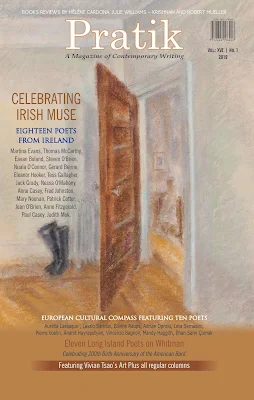Doorway at
Dusk: From Jeddah to New York
One winter afternoon when I passed through the door to the
room in the back, I saw that the sun had cast shadows of the brown door on the
off white wall. A pair of tall boots stood next to the radiator. Outside the
door was a bluish hallway. There were a small framed photo and clothing that
was left on the rail. I suddenly saw a painting. I brought my easel to the
narrow room and began the pastel.
In the moment to moment dialogue with light, I tried to
capture what was in front of me. I discovered that the tones of the white
doorframe kept on changing as the tones of the hallway continued to deepen. I
did not work with any formula. Painting was like sailing out to the unknown.
I often worked in silence. In February, the symphonic play
of color and light in pastel gradually took shape. One afternoon at the end of
the session in 2017, I brought the easel back to the studio. In the bright
light in New York, I studied the picture and realized that I had just added the
last stroke to the new painting Doorway at Dusk. I put down the worn stick in
my hand.
It was in late summer 1977 that I landed in Jeddah, Saudi
Arabia. I joined my husband who was teaching there. I had received an M.F.A.
degree in painting from Carnegie Mellon University in the U.S. As if a dream had
come true, I visited for the first time Paris and Rome on my way to the Middle
East.
In the ride from the airport to our new home, I noticed
outside the car window a giant setting sun. Its flaming red figure seemed to
rest forever on the horizon. Yet suddenly, it left without a trace over the
desert.
My sunny studio was on the second floor of an apartment
building on the street corner. In early afternoon, a shepherd dressed in a robe
often passed by with his goats. The melodic sound of the brass bells around
their necks broke the silence of the sandy street.
As the package of my brushes and oil paints had yet to
arrive, I thought of visiting the local graphic supply store. To my surprise, I
came across a set of 200 pastels. Its fine gradations in red, yellow, blue and
green impressed me. When I began exploring it the next day, I felt a strange
familiarity with the new tool. I sensed that it opened a channel in blending
and in creating the nuanced tones in my picture.
When I set up the easel in front of the mirror in my new
studio, I noticed that the steady sun had outlined the features of the young
woman in the reflection. The light in her eyes and the flowers on her veil
intrigued me. I began painting without hesitation. In the process, I felt a
sense of liberation. I was no longer concerned about the self. Ignited by
curiosity, I used pastel and my finger to create on paper the tones and
textures of my subject.
Several months after I arrived In Jeddah, I realized that I
no longer tried to resolve my painting through theoretical thinking. In pastels
such as Self-Portrait with Veil and The Poet, I jotted down my spontaneous
responses to light.
When I saw for the first time the artworks by Spanish master
Antonio Lopez Garcia in New York in 1986, I was struck by the intimate touch of
his hand. The retrospective show included oils, drawings and sculptures by the
Magic Realist. I felt an affinity with the works from life of his daughter
Maria and of his uncle, painter Antonio Lopez Torres.
His nuanced drawings in pencil sometimes took years to
complete. In infinite changing tones, he captured child Maria in a peacoat. Her
presence was gentle, modest and contemporary. In the drawing Antonio Lopez Torres’House, the elderly
artist passed through the familiar interior in layered silvery light. The back
of Torres in an overcoat drew me in as if in a dream. Whether a window scene of
a street or a mural-sized cityscape, Lopez created images over long periods of
observation. The emotions triggered by his brush were subliminal. They suppress
yet transcend.
Recently, in the narrow room in New York, the afternoon sun
from the two tall windows shined on the Chinese scroll on the wall. The
rhythmic strokes of Chinese calligraphy by my father took me back to his study
in Taipei shortly before I left for graduate studies in the U.S. He wrote the
poem by Li Yi-shan in Tang Dynasty at my request. He carefully stamped his seal
in red ink after writing. Nearby, the bronze-toned spines of the books World
Art Series published by Kawade Shobo in Japan stood on the hand-made bookcase.
Before I had a chance to see the original artworks by Corot and Cézanne, the
series was my Western art museum.
My middle school was within walking distance from the
National Palace Museum in Taiwan. I longed to visit the Museum in construction
outside my classroom window. My first visit in 1965 led me to the discovery of
the hand scroll by Emperor Hui-tsung of Sung Dynasty. In his personal slender
gold style, he wrote the Poem. I felt transported when I read the last lines of
his writing. On darkened silk, the bouncing strokes of the palm-sized
characters read,
“ The dancing butterflies lost their way on the fragrant
path
Their wings chased
after the evening breeze.”
The scrolls of Hui-tsung and of the landscapes by Chinese
masters echoed the mountains and waters that surrounded my school. They and the
Saturday art lessons in the studio of Prof. Sun To-Ze helped plant the seed for
my journey in art across the oceans.




















